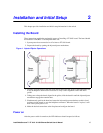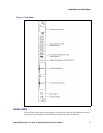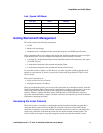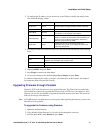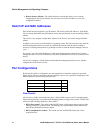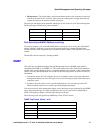
Intel® NetStructure™ ZT 8101 10/100 Ethernet Switch User’s Manual 23
Switch Management and Operating
Concepts 3
This chapter describes many of the concepts you need to understand to configure and manage the
switch. It also describes many of the features available for managing the switch. The instructions
for configuring the switch are in chapter 4 (Telnet Console) and chapter 5 (Web Console).
Managing the Switch
The Intel® NetStructure™ ZT 8101 10/100 Ethernet Switch switch has three methods for
configuring switch parameters and viewing switch status and statistics:
• Serial—The switch’s serial port on the front panel allows a terminal or a PC running terminal
emulation software to be connected to the switch and configure the switch. It uses the same
application that is used over Telnet. The serial port is usually used only for initial set up, such
as configuring the switch’s IP address, or when the network is down. It can also be used to
upgrade the switch’s firmware with Zmodem.
• Telnet—The switch's embedded Telnet server allows users from remote systems, which are
running a Telnet application over TCP/IP, to log in to the switch, configure it, and view the
status of and statistics from the ports. The current implementation allow eight 8 Telnet sessions
to be active at the same time.
• Web—The switch's embedded Web server allows users from remote systems, which are
running a Web browser, to log in to the switch, configure it, and view the status of and
statistics from the ports. The current implementation allows five HTTP sessions to be active at
the same time.
The switch also contains the following utilities:
• Ping—The Ping utility invokes the ICMP echo request and echo reply messages. A host sends
an ICMP echo request message to a specified destination. Any computer that receives an echo
request formulates an echo reply and transmits it to the original sender. The echo request and
associated reply can be used to test whether a destination is reachable and responding.
• TFTP—The TFTP protocol is used to transfer files without any kind of authentication. It runs
on top of UDP, using timeout and retransmission to ensure that data arrives. The switch's TFTP
client allows users to copy files from, and to, a remote system that is running the TFTP server
protocol. The TFTP client allows only one user to access it and transfer files.
You can use the TFTP client to do the following:
— Download firmware.
— Download or upload a switch configuration file.
— Upload the switch's history log.
Some TFTP servers cannot determine when a transaction is aborted. In these cases, you must
reboot the switch, which restarts the TFTP server and re-initializes the TFTP transaction.
• Switch diagnostics—The PROM loader automatically runs memory diagnostics each time the
switch is booted.



